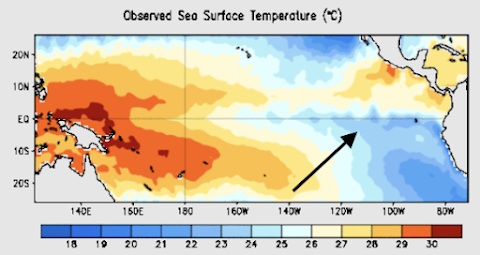La Nina, the periodic occurrence of unusually cool surface waters over the central and eastern tropical Pacific, has a substantial but variable impact on Northwest weather.
Generally, La Nina brings wetter than normal and cooler than normal conditions to the Northwest, often with a healthy local snowpack. Central and southern CA are often dry.
But this year La Nina appears to be following a different playbook, with Calfornia being pummelled with uber-moist storms. And La Nina is about to weaken rapidly, with changes already occurring beneath the Pacific surface.
Here is the latest map of Pacific sea surface temperature. You can see the cool water near the equator over the central/eastern Pacific,
NOAA and other organizations run computer forecast models that predict the future of tropical sea surface temperatures. Here is the prediction of the tempeature anomaly (difference from normal) for the Nino3.4 area in the central tropical Pacific for a collection of many models. Virtually all are going for warming with an end of La Nina by this spring,








What about the mega low?
ReplyDeleteThe next ENSO monthly update,and all the accompanying charts,comes out Thursday.
ReplyDelete"La Nada"... love it!
ReplyDeleteWhat weather conditions-- generally-- are expected as a result of "La Nada" during the spring and summer of this year? Since the climate alarmists are predicting the end of life on earth as we know it in 15 years or less, predicting 2-7 months out shouldn't be a problem. ;)
ReplyDeleteSo, is the atmospheric onslaught directed at California related to the warming of the water in the tropical Pacific and the weakening of La Nina?
ReplyDeleteLa Nina has been a bust throughout the majority of BC this year outside of the southern interior. Been more typical of a El Nino year or 2014/2015 for much of the Province. It was cold and all the storms have been tracking south, now it's mild and all the storms are still tracking south. Here is an image of our current snow pack across the Province. https://i.imgur.com/yeHjmII.jpg
ReplyDeleteDefinitely noticing that this year, outside of the bit of bitter cold just before Christmas does not feel as wet as the 2 years prior. Last year, we had storm, after storm, after storm hit the Puget Sound area much of last fall/early winter, with a bout of bitter cold between Christmas Eve and NYD, resulting in broken or split pipes (I was not spared, unfortunately). Much of those storms subsided by mid February, the year before, snow in February, the year before that I think it was cold, and 2 snows in February.
ReplyDeleteWe even had an unusual event much of the summer of '19 where the overnight low was unusually warm with overnight lows remaining in the mid 60's but the daytime highs that summer were about normal (77-78 or so, or the low 80's most of the summer, but at times cloudy but I think dry, then that major thunderstorm in early Sept broke the dry spell).
The last 2 summers (2020 and 2021) we had the smoke to contend with but otherwise, I think the summers were not overly unusual as far as weather was concerned if I recall.
This last summer, spring and very early summer was not warm, a bit wet and it seemed they made it difficult for tomatoes to grow well last year. I had major problems, maybe one tomato, and it didn't even grow, and part of that was I ended up with ONE bush and likely a lack of pollination did it in as I had issues with starting them from seed as some didn't sprout at all, others delayed sprouting and ended up with 2 seedlings, one stayed alive, but barely produced anything but blooms.